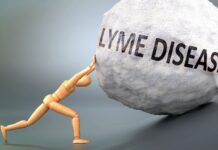In our Pesach Collection of this year, we featured Rea Bochner’s story “Double Helix,” based on the tragic story of a Jewish child lost to his family and his nation. Many readers wrote in asking for more details. Following is the actual happenings our Collection story was based on.
(Reprinted from The Washington Post.)
Five years ago, Alice Collins Plebuch made a decision that would alter her future—or really, her past.
She sent away for a “just-for-fun” DNA test. When the tube arrived, she spit and spit until she filled it up to the line, and then sent it off in the mail. She wanted to know what she was made of.
Plebuch, now 69, already had a rough idea of what she would find. Her parents, both deceased, were Irish American Catholics who raised her and her six siblings with church Sundays and ethnic pride. But Plebuch, who had a long-standing interest in science and DNA, wanted to know more about her dad’s side of the family. The son of Irish immigrants, Jim Collins had been raised in an orphanage from a young age, and his extended family tree was murky.
After a few weeks during which her saliva was analyzed, she got an email in the summer of 2012 with a link to her results. The report was confounding.
About half of Plebuch’s DNA results presented the mixed British Isles bloodline she expected. The other half picked up an unexpected combination of European Jewish, Middle Eastern and Eastern European. Surely someone in the lab had messed up. It was the early days of direct-to-consumer DNA testing, and Ancestry.com’s test was new. She wrote the company a nasty letter informing them they’d made a mistake.
But she talked to her sister, and they agreed she should test again. If the information Plebuch was seeing on her computer screen was correct, it posed a fundamental mystery about her very identity. It meant one of her parents wasn’t who he or she was supposed to be—and by extension, neither was she.
Eventually, Plebuch would write to Ancestry again. “You guys were right,” she’d say. “I was wrong.”
We are only just beginning to grapple with what it means to uncover our genetic heritage cheaply and easily.
Over the past five years, as the price of DNA testing kits has dropped and their quality has improved, the phenomenon of “recreational genomics” has taken off. According to the International Society of Genetic Genealogy, nearly eight million people worldwide, but mostly in the United States, have tested their DNA through kits, typically costing $99 or less, from such companies as 23andMe, Ancestry.com and Family Tree DNA.
The most popular DNA-deciphering approach, autosomal DNA testing, looks at genetic material inherited from both parents and can be used to connect customers to others in a database who share that material. The results can let you see exactly what stuff you’re made from—as well as offer the opportunity to find previously unknown relatives.
For adoptees, many of whom can’t access information about their birth parents because of closed adoption laws, DNA testing can let them bypass years, even decades, of conventional research to find “DNA cousins” who may very well lead them to their families.
But DNA testing can also yield uncomfortable surprises. Some testers, looking for a little more information about a grandparent’s origins, or to confirm a family legend about Native American heritage, may not be prepared for results that disrupt their sense of identity. Often, that means finding out their dad is not actually their dad, or discovering a relative they never knew existed.





















